 | |
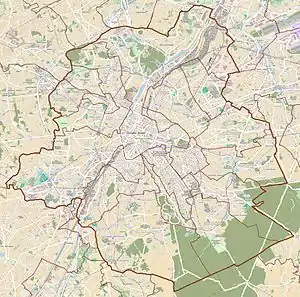 Location within Brussels 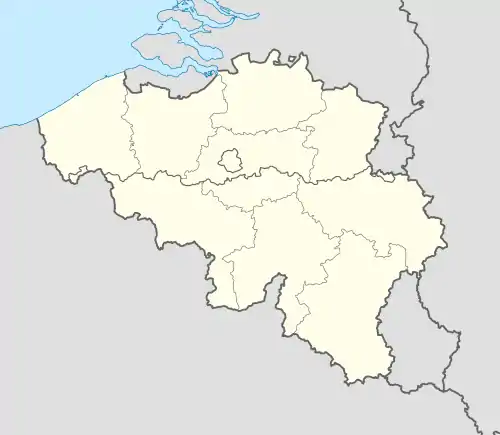 Place des Martyrs, Brussels (Belgium) | |
| Location | City of Brussels, Brussels-Capital Region, Belgium |
|---|---|
| Quarter | Marais–Jacqmain Quarter |
| Coordinates | 50°51′05″N 04°21′22″E / 50.85139°N 4.35611°E |
| Construction | |
| Completion | c. 1776 |
| Other | |
| Designer | Claude Fisco |
The Place des Martyrs (Dutch: Martelaarsplein) is a historic square in central Brussels, Belgium. Its current name, meaning "Martyrs' Square", refers to the martyrs of the September Days of the Belgian Revolution of 1830.
Originally, the square was called the Place Saint-Michel/Sint-Michielsplein after Saint Michael, patron saint of the City of Brussels.[1] It was laid out in a uniform neoclassical style between 1774 and 1776, based on the designs of the architect Claude Fisco. Over 400 heroes of the Belgian Revolution lie buried in a crypt beneath the cobblestones. Many lie not far from where they were shot, in fierce battles amid the Brussels streets and barricades. Nowadays, the square is home to cabinet offices of the Flemish Government, including those of the Flemish Minister-President, as well as a theatre: the Théâtre des Martyrs.[1][2]
The Place des Martyrs is located in the Marais–Jacqmain Quarter, near the Rue Neuve/Nieuwstraat, Belgium's second busiest shopping street.[3][4] It is served by the metro and premetro (underground tram) station De Brouckère on lines 1, 3, 4 and 5.
History
Early history
The Place des Martyrs was built on what was formerly Den Blijck, a bleachfield for washed textiles. In 1773, the City of Brussels, which had acquired this plot of land, commissioned the architect Claude Fisco, controller of the works of the city, to design in its place a new neoclassical square. The works, which also involved digging several arteries, lasted from 1774 until 1776. The square was originally named the Place Saint-Michel/Sint-Michielsplein ("Saint Michael's Square"), after Saint Michael, the city's patron saint.[1] This hodonym indicates the importance that the city's authorities attached to the operation, which was a first in Brussels, where it marked a radical break, aesthetically, typologically and urbanistically, with traditional practices.[5]
In 1776, the then-director of the Théâtre de la Monnoye, Ignaz Vitzthumb, obtained permission to erect a "portable theatre" on the square; a small wooden building, light and removable, on which he gave plays in Dutch. Losing money, the operation resulted in the sale of the theatre in March 1777.[6] In 1795, under the French regime, street and place names with any sort of religious connotation were changed, and the square was temporarily renamed the Place de la Blanchisserie/Blekerijplein ("Laundry Square"), reminiscing the site's original usage.[1][5]
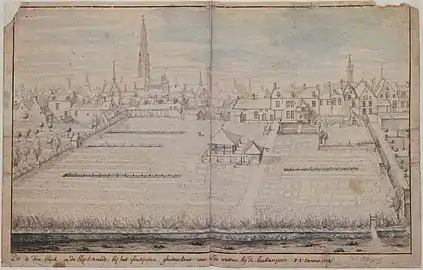 Den Blijck, a bleachfield in Brussels, drawing by Derons, 1748
Den Blijck, a bleachfield in Brussels, drawing by Derons, 1748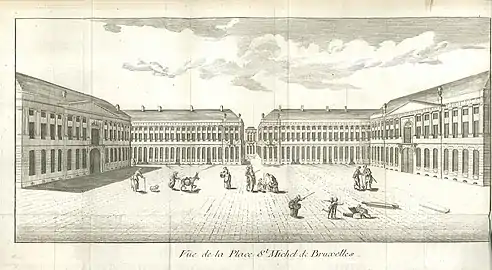 The Place Saint-Michel/Sint-Michielsplein from Description de la ville de Bruxelles enrichie du plan de la ville et de perspectives, 1782
The Place Saint-Michel/Sint-Michielsplein from Description de la ville de Bruxelles enrichie du plan de la ville et de perspectives, 1782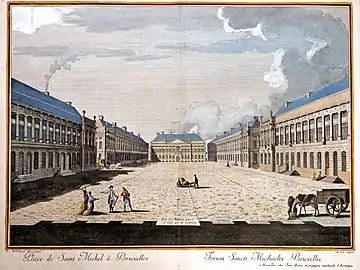 The Place Saint-Michel, aquarelled engraving by Ambroise Orio after a drawing by Bernard Ridderbosch, 1783
The Place Saint-Michel, aquarelled engraving by Ambroise Orio after a drawing by Bernard Ridderbosch, 1783
Later development
The square's layout was modified several times over the centuries. Originally, it was a paved and "empty" square, as seen in engravings from the late 18th century. In 1802, linden trees were planted in its centre.[7] In 1830, after the first victims of the Belgian Revolution had been buried there,[8] the Provisional Government decided, in 1831, to turn the square into a national commemoration place for the victims of the Revolution.[9][8] The Monument to the Martyrs of the 1830 Revolution, also known as the Pro Patria Monument, was erected in 1836–1838. Carved by the court sculptor of King Leopold I, Guillaume Geefs, it includes a statue and crypt.[10]
The construction of the Pro Patria Monument led to a radical alteration of the square by eliminating the perspective of the Rue Saint-Michel/Sint-Michielsstraat towards the Rue du Persil/Peterseliestraat. According to the historian Guillaume Des Marez, the statue is "undeniably too large in size and harms the primitive design of the work".[11] In 1839, the addition of two small fenced flowerbeds surrounded by lampposts on both sides of the monument changed the square's appearance once again, as did the installation of fountains in 1841, which were replaced by pools in 1861.[12] In 1897–98, two smaller monuments were erected there, one in honour of the actor and poet Jenneval,[13] and the other of the Count Frédéric de Mérode.[14]
In the following years, political demonstrations were occasionally held on the square. On 23 September 1884, 3000 socialists disrupted a national commemoration there by singing The Marseillaise and The Carmagnole. The leaders of the demonstration, Jean Volders and Louis Bertrand, were arrested.[15] During the First World War, traditional celebrations were banned, but the population spontaneously gathered on the square to openly protest against the German occupation.

_(14770472351).jpg.webp) The square, c. 1910. Note the gardens and pools on both sides of the monument.
The square, c. 1910. Note the gardens and pools on both sides of the monument. Civilians gather on the square on the first National Day under the German occupation, 21 July 1915
Civilians gather on the square on the first National Day under the German occupation, 21 July 1915
Contemporary (1945–present)
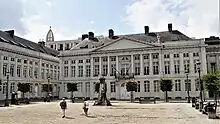
The Place des Martyrs, including the facades and roofs of the buildings, as well as the Pro Patria Monument, received protected status through a royal decree issued on 10 June 1963.[16][17] In 1979–80, the square was partially restored to its original appearance and was repaved. On that occasion, the monuments to Jennevel and to the Count de Mérode were moved further north and south, respectively. The redevelopment also included the replacement of the flowerbeds with new paving and the installation of bollards, public benches and lampposts.[5]
In recent years, several cabinet offices of the Flemish Government, including those of the Flemish Minister-President set up residence on the Place des Martyrs. In 1998, a theatre, the Théâtre des Martyrs, was inaugurated.[2] Nowadays, the square is also home to two bookshops, a youth hostel and a five-star hotel in the buildings at the corner of the Rue Saint-Michel. There is also a masonic temple nearby on the Rue du Persil.[18]
Layout
The Place des Martyrs has a sober and severe appearance, characteristic of neoclassical architecture. It is modelled after the so-called French royal square, as developed at the end of the 17th century. It has a double symmetry, which is best perceived when approaching it from the Rue Saint-Michel. It is divided by two axes, one of which passes through the centre of the long sides, from the Rue Saint-Michel to the Rue du Persil, while the other passes through the centre of the pediments of the short sides.
As is the case for the Place Royale/Koningsplein and the buildings along Brussels Park, the plots of the Place des Martyrs had been encumbered with an architectural servitude testifying to the concern of the authorities to build and preserve a homogeneous ensemble. This homogeneity is achieved in particular by requiring the owners to coat and paint the facades in ash grey and the doors and windows in pearl grey.
The layout of the facades is also uniform: the ground floor has partitions, the depth of which is equal to half that of the incisions, which underline the horizontality of the ensemble. The windows have arched bays. Between the ground floor and the first floor runs a continuous stylobate. The ground floor supports pilasters over a floor and a half. The whole is surmounted by a frieze with triglyphs and metopes and crowned with an attic. The facades have a continuous gable roof.
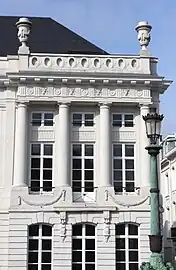 Avant-corps of a corner building towards the Rue Saint-Michel
Avant-corps of a corner building towards the Rue Saint-Michel

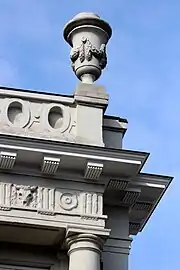 Corner of the avant-corps surmounted by a frieze, an attic and a vase
Corner of the avant-corps surmounted by a frieze, an attic and a vase
Monuments
Several commemorative monuments are located on the Place des Martyrs:
- the Monument to the Martyrs of the 1830 Revolution or Pro Patria Monument, commemorating the victims of the Belgian Revolution, by Guillaume Geefs and Louis Roelandt (1836–1838)[10]
- the Monument to Jenneval, honouring Alexandre Dechet (commonly known as Jenneval), the author of the text of The Brabançonne (Belgium's national anthem) by Alfred Crick and Émile Anciaux (1897)[13]
- the Monument to Count Frédéric de Mérode, in Art Nouveau style, dedicated to Count Frédéric de Mérode, by Paul Du Bois and Henry Van de Velde (1898)[14]
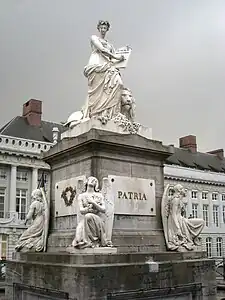 Monument to the Martyrs of the 1830 Revolution (Geefs, 1836–1838)
Monument to the Martyrs of the 1830 Revolution (Geefs, 1836–1838) Monument to Jenneval (Crick and Anciaux, 1897)
Monument to Jenneval (Crick and Anciaux, 1897) Closeup of white marble plaque with the effigy of Jenneval
Closeup of white marble plaque with the effigy of Jenneval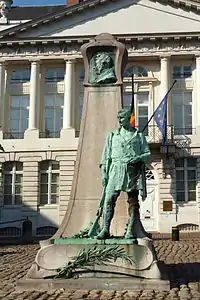 Monument to Count Frédéric de Mérode (Du Bois and Van de Velde, 1898)
Monument to Count Frédéric de Mérode (Du Bois and Van de Velde, 1898) Closeup of the bronze medallion bearing Frédéric de Mérode's image
Closeup of the bronze medallion bearing Frédéric de Mérode's image
See also
References
Citations
- 1 2 3 4 Gérard 2023, p. 17.
- 1 2 Martyrs, Théâtre des. "Théâtre des Martyrs" (in French). Retrieved 1 July 2020.
- ↑ "Rue Neuve most popular shopping street". www.xpats.com. 19 September 2013. Retrieved 18 October 2017.
- ↑ "Meir klopt voor het eerst Nieuwstraat als drukste winkelstraat". De Standaard (in Flemish). 7 January 2013. Retrieved 18 October 2017.
- 1 2 3 "Place des Martyrs: ensemble architectural – Inventaire du patrimoine architectural". monument.heritage.brussels (in French). Retrieved 11 August 2022.
- ↑ Gazette des Pays-Bas, 3 March 1777
- ↑ Valente Soares 2011, p. 47.
- 1 2 Valente Soares 2011, p. 49.
- ↑ Mardaga 2005, p. 112.
- 1 2 Mardaga 1993, p. 447.
- ↑ Des Marez 1918, p. 218.
- ↑ Valente Soares 2011, p. 54.
- 1 2 Valente Soares 2011, p. 51–53.
- 1 2 Valente Soares 2011, p. 53.
- ↑ Gita Deneckere, 1900: België op het breukvlak van twee eeuwen, 2006, p. 60
- ↑ Valente Soares 2011, p. 62.
- ↑ "Bruxelles Pentagone - Monument aux Martyrs de la révolution de 1830 - Place des Martyrs - ROELANDT L." www.irismonument.be. Retrieved 8 December 2018.
- ↑ "eBru | Temple maçonnique Cercle des Amis philanthropes | Pentagone (1000 Bruxelles)". www.ebru.be. Retrieved 7 April 2021.
Bibliography
- D'Hainaut-Zveny, Brigitte (1994). La Place des Martyrs (in French). Brussels: CFC Éditions. ISBN 978-2-930018-00-3.
- Derom, Patrick (2000). Les sculptures de Bruxelles (in French). Antwerp: Pandora. ISBN 978-90-5325-119-5.
- Des Marez, Guillaume (1918). Guide illustré de Bruxelles (in French). Vol. 1. Brussels: Touring Club Royal de Belgique.
- Gérard, Hervé (2023). Bruxelles et ses places (in French). Brussels: 180° éditions. ISBN 978-2-940721-32-0.
- Valente Soares, Paulo (2011). La Place des Martyrs des origines à nos jours (in French). Brussels: CFC Éditions. ISBN 978-2-930018-86-7.
- Le Patrimoine monumental de la Belgique: Bruxelles (PDF) (in French). Vol. 1B: Pentagone E-M. Liège: Pierre Mardaga. 1993.
- Bruxelles, 175 ans d'une capitale (in French). Liège: Pierre Mardaga. 2005. ISBN 978-2-87009-905-6.
External links
 Media related to Place des Martyrs/Martelaarsplein at Wikimedia Commons
Media related to Place des Martyrs/Martelaarsplein at Wikimedia Commons